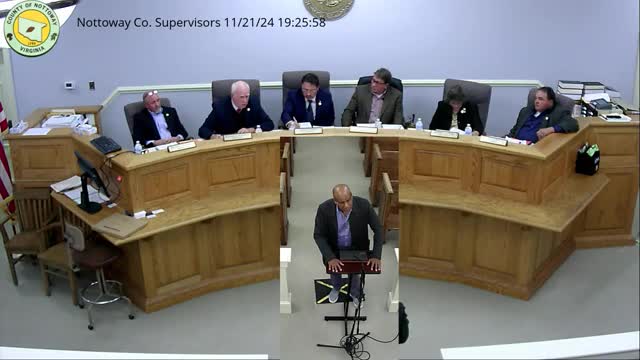Solar Ordinance Sparks Debate Over Environmental Regulations
November 22, 2024 | Nottoway County, Virginia
This article was created by AI summarizing key points discussed. AI makes mistakes, so for full details and context, please refer to the video of the full meeting. Please report any errors so we can fix them. Report an error »

In a recent government meeting, discussions centered around the development of solar energy projects and the regulatory framework governing them. Key points included the need for revisions to the current solar ordinance, which some members believe is overly restrictive and hinders the potential for smaller solar projects.
Robert Hawthorne Jr. emphasized the importance of updating the ordinance to facilitate the approval of smaller solar initiatives, which could provide funding for local projects and alleviate some tax burdens. He noted that the existing regulations, which require solar projects to exceed 5 megawatts for certain siting agreements, limit opportunities for smaller developments that could benefit the community.
Hawthorne also highlighted the need for a comprehensive review of a previously crafted solar ordinance that had garnered positive feedback from neighboring counties. He urged the board to revisit this plan, suggesting that it contained strong protections while remaining workable for developers.
Concerns were raised regarding the environmental impact of solar panels, particularly those made with cadmium telluride technology. However, it was clarified that the panels currently in use by local projects do not pose a toxic risk, even if breached, according to studies from the Department of Energy and the Department of Agriculture.
The meeting also touched on enforcement issues related to solar project compliance, with some members expressing frustration over instances where companies opted to pay fines rather than rectify violations. This raised questions about the effectiveness of regulatory oversight and the need for stricter enforcement to ensure compliance with environmental standards.
Overall, the discussions underscored a growing interest in expanding solar energy initiatives while navigating the complexities of local regulations and environmental concerns. The board plans to continue these discussions in future meetings, with a focus on creating a more favorable environment for solar development in the region.
Robert Hawthorne Jr. emphasized the importance of updating the ordinance to facilitate the approval of smaller solar initiatives, which could provide funding for local projects and alleviate some tax burdens. He noted that the existing regulations, which require solar projects to exceed 5 megawatts for certain siting agreements, limit opportunities for smaller developments that could benefit the community.
Hawthorne also highlighted the need for a comprehensive review of a previously crafted solar ordinance that had garnered positive feedback from neighboring counties. He urged the board to revisit this plan, suggesting that it contained strong protections while remaining workable for developers.
Concerns were raised regarding the environmental impact of solar panels, particularly those made with cadmium telluride technology. However, it was clarified that the panels currently in use by local projects do not pose a toxic risk, even if breached, according to studies from the Department of Energy and the Department of Agriculture.
The meeting also touched on enforcement issues related to solar project compliance, with some members expressing frustration over instances where companies opted to pay fines rather than rectify violations. This raised questions about the effectiveness of regulatory oversight and the need for stricter enforcement to ensure compliance with environmental standards.
Overall, the discussions underscored a growing interest in expanding solar energy initiatives while navigating the complexities of local regulations and environmental concerns. The board plans to continue these discussions in future meetings, with a focus on creating a more favorable environment for solar development in the region.
View full meeting
This article is based on a recent meeting—watch the full video and explore the complete transcript for deeper insights into the discussion.
View full meeting
